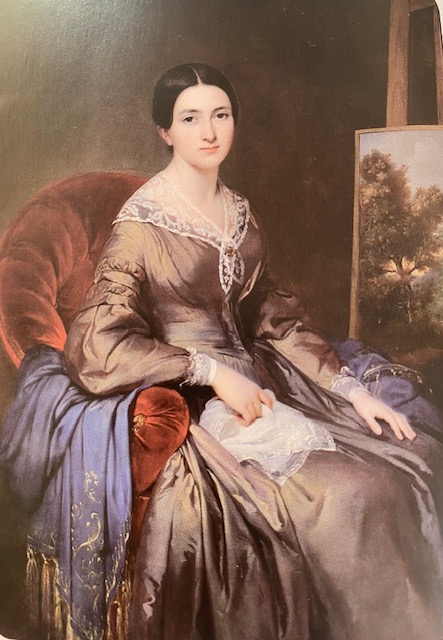

 |
|
||
| < Back to Robert Shirley, 6th Earl Ferrers | |||
 An English Flower Transplanted to An English Flower Transplanted to Italian Soil Published in London by Longman, Green, Longman and Roberts; Paternoster Row, 1863. THE seventh Earl Ferrers inherited some of that eccentricity of his family which, in the case of one of his line had led to such sad results. Disliking the splendid seat of Staunton Harold, probably from the painful associations connected with it, he erected mansions on other portions of his large estates. Rakedale Hall was one of these, Ratcliff Hall was another. He had quarrelled with his only son, the amiable and accomplished Lord Tamworth, and the latter had died without any reconciliation having taken place. [see pedigree of the Earls Ferrers] The Earl had lost his last Countess, the daughter of Mr. Wrightson Mundy, and was living in moody retirement at Rakedale Hall, when an occurrence took place that afforded him an opportunitv of making some atonement for the harshness he had shewn to his lamented son. One morning a woman of plebeian appearance came to the Hall, and at first requested, and then, being refused, demanded an audience of his lordship. She was at last ushered into the study, and she led by the hand a little girl of three years old, for whose support, as the grandchild of the Earl, she supplicantly pleaded for some assistance. While the mother was telling the tale of her troubles, the little one began to play with the stern Earl's shining knee-buckles. He looked down, on the child, and, relaxing and relenting, said, " Ay, you have Tamworth's eyes." This likeness to Lord Tamworth, the little one's innocent prattle, and perhaps some compunctious feelings for his late coldness to his son, made a strong impression on the Earl's heart. He took the child on his knee ; his stern heart was softened, and from that moment he formed the resolution of adopting her. During his life-time she never left him, but became the solace of his declining years. He bestowed great pains on her education, and by his will appointed Mr. Charles Godfrey Mundy, of Burton Hall, her sole guardian, with an allowance of three thousand pounds a-year for her maintenance during minority, and bequeathed her the beautiful manors of Rakedale, Ratcliife, &c. &c., with a large amount of personal property. [see 1842 Chancery Court suit of Shirley vs. Ferrers regarding the inheritance of Caroline Shirley] Miss Shirley, as she was always called, was removed to Burton Hall. For years she had been entirely separated from her mother, who had married an humble innkeeper of Syston, receiving a small annuity, on condition that she should not have any intercourse with her daughter. The latter had, indeed, been led to believe that her mother was no more, and had, of course, been considerably mystified as to her origin, when a stranger arrived at Burton Hall. It was she who, fifteen years before, had demanded an interview with Earl Ferrers.Inquiry was made as to the nature of the woman's business. It was to see her daughter, Miss Shirley, and she declared that nothing but force should remove her from the Hall door, till she had accomplished the purpose of her visit. A family council was held, and at length it was stipulated that she should be admitted into the room in which Miss Mundy, Miss Shirley, and some other ladies were sitting, on the pretext of being shown the pictures and the furniture ; and thus be allowed a look at her daughter, without in any way discovering herself. She was brought in by one of the domestics. The young ladies pursued their drawing, none of them being at all conscious of any relationship between themselves and the rustic stranger. A picture or two had been described, but the woman's eye could not be diverted, she only saw her daughter, and in her overpowering emotion, threw herself on her daughter's neck. The scene need not be described further.
The little girl whom I first introduced to the reader in the character of an humble suppliant at the door of Rakedale Hall, is now Duchess de Sforza, wife of one of the most distinguished men in Europe, and owner of Rakedale Hall itself, and the fine estates that surround it. The Duke and Duchess reside on the Duke's ancestral home in Romagna. They rarely visit England. Three or four years ago, a stranger and his wife were observed sketching for several days in succession the remarkable ancient manor-house of the Shirleys, called Rakedale Old Hall. This was nothing new to the villagers, as the fine old Jacobean house, with its beautiful chimneys and the picturesque chapel adjoining, is a frequent subject for the amateur's or the artist's pencil. The supposed artist and his wife came, however, so often from Leicester that they formed an acquaintance with all the farmers and cottagers in the romantic valley. They were only too happy to be allowed to take refreshment at the farm houses, for the village contains no inn. They entered freely into conversation with the people, heard the free-spoken sentiments of the farmers about farming and their foreign landlady, and became such favourites that they met with a hearty welcome in every house. Even the children of the village learnt to love the strangers for their gentle manners, and still more, perhaps, for the presents that were bestowed upon them ; and there was a universal gloom in the village, when the "artist and his wife" announced that they would not return again. The morning af:er their departure, a letter was received by the principal farmer, conveying grateful thanks to the inhabitants for their kind and hospitable attentions, and enclosing a cheque for a handsome sum for distribution among the cottagers and their children. That letter destroyed the incognito. The artist and his wife were the DUKE AND DUCHESS DE SFORZA. The Duchess had enjoyed the happiness of revisiting, unobserved, scenes endeared to her from childhood, and of introducing her husband to the rural life of England and their happy and kind-hearted tenantry. The bells of the little chapel were soon set a-going ; but the villagers' joy was not a little damped by thinking of bows and curtseys that would have been made, and of sayings that would have been unsaid, had they for one moment imagined it was the Duchess de Sforza! Another incident, having reference to this same Vale of Rakedale, will close my little story. In the summer of 1861 an antiquary, rambling in North Leicestershire, was induced to visit this secluded hamlet, a few miles east of Melton Mowbray. He had been attracted to this spot by the fame of the old Hall as a remarkably fine specimen of Jacobean architecture. He was descending the hill that overhangs the village, when groups of well-dressed rustics met his eye. The word "Welcome," too, affixed in flowers on an arch that spanned the entrance to the Hall, gave sign of rejoicing. "What holiday are you celebrating ?" said my antiquarian friend to the civil rustic who opened the gate. " It's the visit of the Duchess," was the reply; "and there she comes," said he, pointing to a carriage descending the hill. A loud shout proceeded from the rustics, and the two bells of the little chapel adjoining the Hall at once began to jingle the best peal the dual could produce. The carriage entered the Hall gates, and a lady of middle age was handed out by a soldier-like young man who accompanied her. With bare heads the farmers and labourers made their best bows, and their wives and daughters dropped their best curtseys, and the lady was conducted into the Hall. A bountiful feast had been prepared in a well-decorated barn, and my friend was hospitably invited to share in the festivities. The Duchess soon entered, leaning on the arm of her son, and both sat down with great good nature at the head of the well-plenished table. The repast over, the principal tenant proposed the health of the Duchess, which was gracefully acknowledged by her son, the young officer at her side. Other toasts followed, intermingled with pleasant but, on the part of the villagers, deferential chat, and then rural sports became the order of the day. Of these, the Duchess of Sforza was evidently a delighted spectatress. The young soldier, who accompanied her on this visit to her Leicestershire tenantry, was one of her sons, the Duke de Cenis, an officer in the army of Victor Emmanuel. Thanks to Prof. Alfredo Maulo and Doct. Alvise Manni at
the institute www.ducatocesarini.it for sending the portrait
of the Duchess of Sforza and the Shirley coat of arms found at
the Sforza palace.   Duchess Caroline (Shirley) Sforza Cesarini "This is a portrait of her by Francesco Podesti still belonging to the family." |
|||
|
All Rights Reserved |
|||